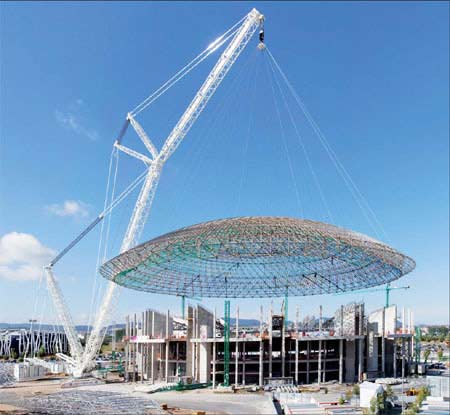Pick-me-up for groggy weightlifters
Updated: 2012-11-03 15:04
By Zhong Nan (China Daily)
|
||||||||
Foreign crane makers get uplift from government infrastructure projects
After enduring more than a year of sales slump, business is beginning to look up again for foreign crane makers in China as the country loads more money into large-scale infrastructure projects.
Sales of mobile cranes, which account for 80 percent of the market, were almost halved from 23,365 units in the first half of 2011 to 12,092 in the second half, according to data from the China Construction Machinery Association.
Both international and domestic crane producers have been affected since August 2011, with demand down 20 percent in the first half of this year, says CCMA President Qi Jun.
"Preferential government policies and a considerable amount of investment in infrastructure, affordable housing and large-scale green energy projects is urgently needed, to improve market conditions and stimulate brisk sales for crane producers," Qi says.
That stimulus is already underway. Led by local governments at different levels, a new wave of investment is expected to spur domestic demand.
In early September, the National Development and Reform Commission, China's macroeconomic management agency under the State Council, approved subway construction projects in 23 Chinese cities, with a total investment of 840 billion yuan ($134 billion; 104 billion euros).
A further 21 road, highway and port projects, 10 environmental protection projects, 76 clean energy projects, and several hydropower station and airport construction projects have also been approved by the NDRC.
"Based on the regional characteristics, the investment will be on the sectors that have strong market growth potential and function to further stimulate domestic consumption," says Zhang Yansheng, secretary-general of the NDRC's academic committee.
"Investment has moved to sectors such as special equipment and automobile manufacturing," Zhang says.
"In August, the amount of bank loans and the number of new projects all rose faster than expected. More manufacturing of machinery such as cranes and excavators is needed."
Kevin Bradley, president of Terex Cranes, part of the US-based Terex Corp, one of the largest heavy equipment manufacturers in the world, says even though the crane market in China has been down in the past 13 months, moderate growth will begin as China demonstrates its commitment to improving infrastructure.
"The economic prosperity from infrastructure investment in the past is clear, and they will likely stimulate the economy (again) the same way because it will bring long-term benefit to the country," Bradley says. "Even though our sales and revenue have decreased in China this year, I believe we will see growth again, sometime in 2013."
Terex has been realigning its position in the market. The company, which has a truck crane joint venture with Sichuan Changjiang Engineering Crane Co Ltd in Luzhou, Sichuan province, has now added another partner - China Sinomach Heavy Industry Corp, a wholly owned subsidiary of China National Machinery Industry Corporation, a Fortune 500 Global company.
This deal, in which Sinomach owns more than 50 percent of the business, will provide more sales opportunities to Terex and SCE in both foreign and domestic markets.
Bradley says wind energy projects had driven a significant percentage of demand for many years, not only in China, but globally.
"The new product our company will bring to the China market will be the 1,000-metric-ton all-terrain crane, which is very suitable for installing devices for wind energy projects."
The focus on wind and other clean energy comes as China tries to shift away from fossil fuels and cut carbon dioxide emissions by 17 percent per unit of GDP by 2015. China's on-grid wind power capacity is expected to reach 100 gigawatts by 2015 and 200 gigawatts by 2020, according to the State Grid, the country's largest utility company.
"We have seen the trend, needs and opportunities for specifically designed cranes, such as machines that can be applied in the marine industry or special geographical locations like oilfields or plateaus," says Bradley. "We would like to develop more purpose-built cranes to meet the growing demand in this market."












